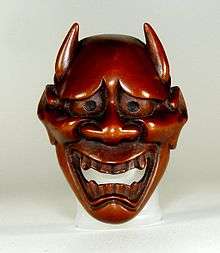Hannya
The Hannya (般若) mask is a mask used in Noh theater, representing a jealous female demon. It possesses two sharp bull-like horns, metallic eyes, and a leering mouth.[1]

Origin of the name
The name hannya (般若) is a Sino-Japanese word for prajna or wisdom. One tradition states that this name was given to this mask because it was the name of an artist monk Hannya-bō (般若坊) who is said to have perfected its creation.[2][3] An alternative explanation is that the artist would need a great deal of wisdom in order to create this mask.[4]
Characteristics
The Hannya mask is used in many noh and kyōgen Japanese plays, as well as in Shinto ritual kagura dances.[5] The Hannya mask portrays the souls of women who have become demons due to obsession or jealousy (similar to the Buddhist concept of a Hungry ghost). Plays in which a person may wear the hannya mask include Aoi no Ue and Dōjōji; its use in these two plays, two of the most famous of the Noh repertoire, and its distinctive and frightening appearance make it one of the most recognizable Noh masks.
The Hannya mask is said to be demonic and dangerous but also sorrowful and tormented, displaying the complexity of human emotions. When the actor looks straight ahead, the mask appears frightening and angry; when tilted slightly down, the face of the demon appears to be sorrowful, as though crying. The oldest hannya mask is dated 1558.
Hannya masks appear in various skin tones: a white mask indicates a woman with a refined character (such as the aristocratic lady Rokujō in Aoi no Ue), a red mask depicts a less refined character (like the spirit of peasant girl seen in Dōjōji), and the darkest red depicts true demons (revealed after appearing as women, as in Momijigari and Kurozuka.)[6][7]
In popular culture
In the film Onibaba the older woman wears a Hannya mask after stealing it from a Samurai.
In the mobile game Onmyoji, Hannya is a shikigami who has a hannya mask on his forehead and another huge one on his back.
In the Yakuza series, the character Goro Majima has a large tattoo of a Hannya on his back. He also has an alter-ego, Hannya-Man, in Yakuza Kiwami, that wears a Hannya mask.
In a Detective Conan anime-only case, a woman who killed the people who drove her sister to suicide used the Hannya as a murder motif. The Hannya legend also influences a local tradition that follows the story of two envious girls who set up another named Ohana to be executed so they can steal her various kimonos, but end up murdered by Ohana's vengeful soul, reborn as an immortal demon.[8]
Plays associated with Hannya
- Aoi no Ue - worn by the Lady Rokujō in her second-half appearance as a demon.
- Dōjōji - can be worn by the dancing woman in her second-half appearance as a snake, though the Shinja (真蛇) mask is also used.
- Kurozuka (known in the Kanze school as Adachigahara) - worn by the spinning woman of Adachigahara after she is revealed to be a demon.
- Momijigari - can be worn by the noblewoman after she is revealed to be a demon.
See also
References
- "hannya". Japanese Architecture and Art Net Users System JAANUS.
- "Onryô - Hannya". the-noh.com.
- "hannya". Japanese Architecture and Art Net Users System JAANUS.
- "Onryô - Hannya". the-noh.com.
- Sadler, A.W (1970). "'O-Kagura'. Field Notes on the Festival Drama in Modern Tokyo". Asian Folklore Studies. 29: 294. JSTOR 1177614.
- Coldiron, Margaret (2005). "Lions, Witches, and Happy Old Men: Some Parallels between Balinese and Japanese Ritual Masks". Asian Theatre Journal. 22 (2): 227–248. JSTOR 4137132.
- Bethe, Monica; Emmert, Richard (1997). Aoi no Ue, Noh Performance Guide 7. Tokyo: National Noh Theatre.
- The Case of the Furisode at the Hidden Hot Spring on a Snowy Night
External links
- Netsuke: masterpieces from the Metropolitan Museum of Art, an exhibition catalog from The Metropolitan Museum of Art (fully available online as PDF), which contains many examples of Hannya